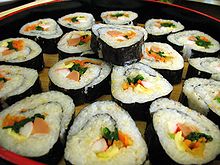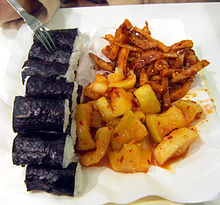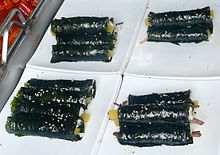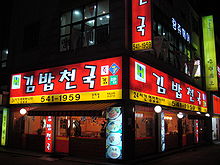- Gimbap
-
Gimbap 
Platter of sliced gimbapKorean name Hangul 김밥 Revised Romanization gimbap McCune–Reischauer kimbap Gimbap or kimbap is a popular Korean dish[1] made from steamed white rice (bap) and various other ingredients, rolled in gim (sheets of dried laver seaweed) and served in bite-size slices.[2] Gimbap is often eaten during picnics or outdoor events, or as a light lunch, served with takuan or kimchi.[3]
Gimbap is derived from Japanese futomaki (Makizushi) during the Japanese rule (1910-1945).[4][5][6][7][8]
Contents
Ingredients
The most basic component of gimbap is rice. From there, you can find many variations on the filling, including fish, meat, eggs, and vegetables, whether pickled, roasted, or fresh.
Traditionally, the rice is lightly seasoned with salt and sesame oil/perilla oil. Popular protein ingredients are fish cakes, imitation crab meat, eggs and/or seasoned beef rib-eye. Vegetables usually include cucumbers, spinach, carrots and danmuji (pickled radish). After the gimbap has been rolled and sliced, it is typically served with danmuji.
Varieties
Short grain white rice is usually used, although short-grain brown rice, like olive oil on gim, is now becoming more widespread among the health-conscious. Rarely, sweet rice is mixed in gimbap rice.
Nowadays, the rice in kimbap can be many kinds of black rice, boiled rice and cereals etc.
Gim is dried, pressed seaweed made from the edible species, laver. Gim may be roasted and seasoned with oil and salt, roasted but unseasoned, or raw and unseasoned. The oil used for roasting gim is traditionally sesame oil; however, today, corn and canola oils are also commonly used, especially with the pre-seasoned packs of gim sold widely in stores. Olive oil is also becoming more prevalent. For gimbap, the roasted, unseasoned variation is typically used.
Besides the common ingredients listed above, some varieties may include cheese, spicy cooked squid, kimchi, luncheon meat, or spicy tuna. The gim may be brushed with sesame oil or sprinkled with sesame seeds. In a variation, sliced pieces of gimbap may be lightly fried with egg coating.[2]
Samgak gimbap (삼각김밥) is a triangle-shaped gimbap sold in many convenience stores in South Korea. Samgak gimbap also come in many varieties.[9]
'Chungmu gimbap (충무김밥) is a gimbap made with only rice as the filler ingredient. Originating from the seaside city of Chungmu, the rolls are thinner and the surface is usually left unseasoned. Chungmu gimbap is traditionally served with side dishes of kolddugi muchim (꼴뚜기 무침), sliced baby octupus marinated and fermented in a spicy red pepper sauce, and radish kimchi (무김치).[10] chamchi kimbap (참치김밥) is another commonly found gimbap. It is usually filled with tuna, marinated sesame leaf, mayonnaise as well as other ingredients.
International familiarity
Gimbap was selected as one of the top 100 foods of Korea for foreigners.[11] Canada's largest urban weekly, straight.com, spotlighted gimbap in an article comparing it with sushi entitled "Korean Kimbap Rolls Out of Sushi's Shadow".[12] The article ends with this comment: "No need for soy sauce, wasabi, or pickled ginger: kimbap stands alone. It's a star waiting to be discovered."
Franchise
Many South Korean fast food restaurant franchises specialize in gimbap and noodles, and these establishments are extremely diverse in the cuisine they offer. Such chains include Gimbap Heaven (김밥천국), Gimbap Land (김밥나라), Gimgane (김家네), Gimbap and Spaghetti (김밥과 스파게티) and so on. These restaurants serve not only gimbap but also numerous other dishes, ranging from small snacks to pork cutlets, ramyeon, bibimbap and other dishes.[13]
Nutrition Facts
Serving Size(g) 250 Calories(kcal) 397 Carbohydrate(g) 71.3 Protein(g) 11.8 Lipid(g) 6.6 Cholesterol(mg) 86.6 Dietary Fiber(g) 0.8 Calcium(mg) 72 Iron(mg) 2.6 Sodium(mg) 669 Vitamin A(㎍ R.E) 347.9 Vitamin B2(mg) 0.22 Vitamin C(mg) 11.4 Vitamin E 1.91 References
- ^ Kimbap, excerpt from Andrew J. Luxner's American English: A Teachers's Journey in Seoul, South Korea. Golden Hill Books, San Diego. ISBN 0-9760748-1-8
- ^ a b (Korean) Gimbap at Doosan Encyclopedia
- ^ (Korean) Gimbap at Encyclopedia of Korean Culture
- ^ Levinson, David; Christensen, Karen (2002). Encyclopedia of Modern Asia: China-India relations to Hyogo. Charles Scribner's Sons. ISBN 0684806177. http://books.google.com/books?id=tlcOAQAAMAAJ&q=kimbap&hl=en. "This process was initiated during the Japanese occupation (1910-1945), when Western food and drink, such as bread, confectionery, and beer, became popular in Korean cities, and a Western-style food processing industry in Korea began. Some Japanese food items were also adopted into Korean cuisine at that time, such as tosirak (the assorted lunch box) and sushi rolled in sheets of seaweed, which was popular in Korea under the name of kimbap."
- ^ Brunner, Anne (2011) (in Spanish). Algas/ Algae: Sabores Marinos Para Cocinar/ Marine Flavors for Cooking. Editorial HISPANO EUROPEA. ISBN 8425519772. http://books.google.com/books?id=WbdomL8utOIC&pg=PT21&dq=gimbaps+maki&hl=en#v=onepage&q=gimbaps%20maki&f=false. "En Corea, los gimbaps son derivados de los maki sushis japoneses, pero generalmente están rellenos de arroz con aceite de sésamo y carne. [In Korea, gimbaps are derived from the Japanese maki sushi, but they are usually stuffed with rice with sesame oil and meat.]"
- ^ "김밥 [Gimbap]" (in Korean). 한국민족문화대백과[Encyclopedia of Korean National Culture]. http://100.nate.com/dicsearch/pentry.html?s=K&i=244176&. "일본음식 김초밥에서 유래된 것으로 [(Gimbap is) derived from Japanese norimaki]"
- ^ 국립국어연구원 [National Institute of Korean languages] (2002) (in Korean]). 우리 문화 길라 잡이: 한국인 이 꼭 알아야할 전통 문화 233가지 [Guide To Our Culture: 233 kinds of Korean traditional culture for you to know]. 학고재 [Hakgojae]. p. 479. ISBN 8985846973. http://books.google.com/books?id=iFZKAQAAIAAJ&q=%22%EA%B9%80%EC%B4%88%EB%B0%A5%22+%22%EA%B9%80%EB%B0%A5%22&hl=en. "일본 음식인 김초밥 에서 유래 한 것으로 [(Gimbap is) derived from Japanese norimaki]"
- ^ "Gimbap" (in Korean). Ministry of Culture, Sports and Tourism Korea. http://www.mcst.go.kr/web/cultureInfoCourt/storyTell/storyTellView.jsp?pSeq=177. "일본음식에서 유래된 것으로 [(Gimbap is)derived from the Japanese food]"
- ^ (Korean) Popularity of samgak gimbap, The Financial News, 2008-11-24. Retrieved 2010-06-25.
- ^ (Korean) Chungmu gimbap at Doosan Encyclopedia
- ^ (Korean) "우리나라를 대표하는 음식 100가지" Yonhap News, 2007-12-03.
- ^ Carolyn Ali "Korean kimbap rolls out of sushi's shadow", Straight.com, June 7, 2007.
- ^ (Korean) Gimbap franchises popular, Edaily EFN, 2008-09-04. Retrieved 2010-06-25.
- ^ (Korean) Nutrition Fact for Consumers(소비자가 알기 쉬운 영양기표), National Academy of Agricultural Science, Kim, Se-na
See also
External links
- Gimbap recipe at Chow Times
- (Korean) Tuna gimbap recipe at Naver Kitchen
- Traditional Gimbap Recipe, Korean-Cooking.com
Categories:- South Korean cuisine
- Korean snacks
- Rice dishes
Wikimedia Foundation. 2010.



